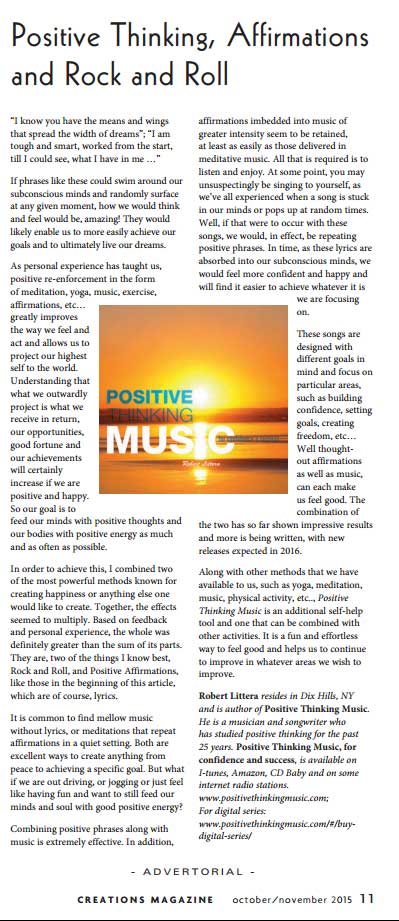Appears in HealthGuidance.org by Mack Lemouse.
Optimism and positive affirmations are two of the most powerful tools we have in our arsenal for getting what we want out of life and being successful in everything we do. Unfortunately both are also highly under-rated and underused and many people wouldn’t know how to go about using them even if they wanted too.
There’s also a lot of stigma surrounding the concept of using positive affirmations to get results and the perception of many is that it’s an esoteric and superstitious view that doesn’t come anywhere near actually putting in the hard work needed to achieve your goals and dreams in life. This is seriously missing the point however, as the fact is that it’s positive affirmations and optimism that give us the drive and the ambition we need to put that work in in the first place. Fortunately people’s faith in the power of positive thinking can often be improved when you explain to them the exact processes by which they work; it’s not some mystical force – but observable social and psychological processes that give positive thinking techniques their effectiveness.
The first way by which positive thinking helps us achieve what we want is through something called a ‘self fulfilling prophecy’. This term explains the fact that by believing we have certain attributes we then begin to behave as though we do which eventually leads to us actually developing them. For example, say you believe yourself to be a highly successful business man (or woman). If you genuinely believe this then the chances are you’ll begin to dress and act differently – you’ll wear more expensive suits and watches, carry briefcases and stand and walk more confidently. At the same time you’ll enjoy your work more as you’ll believe yourself to be good at it and so will put in more effort. Over time superiors and colleagues will begin to notice this change in behaviour and will notice that you not only look the part but have increased your productivity and can speak and present more efficiently. This will then mean they’ll be more likely to pick you for important projects or to offer you a raise. Alternatively you may simply learn from your extra work and feel more confident from your positive affirmations and bite the bullet and set up your own small business. In these ways you’ll then over time actually become a more successful business man.
By DANIEL GOLEMAN in the New York Times
Published: February 03, 1987
POLLYANA was right, new research shows.
Optimism – at least reasonable optimism – can pay dividends as wide-ranging as health, longevity, job success and higher scores on achievement tests.
Pessimism not only has the opposite effect but also seems to be at play in such psychological disorders as extreme shyness and depression.
The new research is an outgrowth of earlier work on the power of self-fulfilling prophecies. That early work concentrated largely on how individuals tend to conform to others’ expectations of them, a phenomenon known as the ”Pygmalion effect.” If anything, researchers have found, the Pygmalion effect is more pervasive than had been thought. The new work looks at people’s expectations about their own lives and finds that the power of expectations goes beyond mere achievement to visceral, emotional qualities.
”Our expectancies not only affect how we see reality but also affect the reality itself,” according to Edward E. Jones, a psychologist at Princeton University, who reviewed the research on expectancy in a recent issue of Science.
Michael F. Scheier, a psychologist at Carnegie-Mellon University in Pittsburgh, has found that optimists handle stress better than do pessimists. In a report in the current issue of the Journal of Personality and Social Psychology, he wrote that optimists tend to respond to disappointments like being turned down for a job by formulating a plan of action and asking other people for help and advice; pessimists more often react to such difficulties by trying to forget the whole thing or assuming there is nothing they can do to change things – an attitude optimists adopted only when there was objectively nothing that could be done.
In one of the more hotly pursued lines of investigation, psychologists are tracking the importance of how people explain their failures to themselves. People tend to have a habitual explanatory style, a typical way of explaining the events that befall them, according to work by Martin Seligman, a psychologist at the University of Pennsylvania.
Pessimists, Dr. Seligman has found, tend to construe bad events such as flunking an exam or giving a party that flops as resulting from a personal deficit that will plague them forever in everything they do. Others see the same setbacks more optimistically, as being due to mistakes that can be remedied. They feel they can make the necessary changes.
Most people mix a pessimistic and an optimistic outlook to some degree. The new research findings apply most strongly to those people at the extremes, who most clearly exemplify one style or the other.
Work by several researchers has shown that people who tend to blame themselves for their misfortunes are more susceptible to disease. For example, George Valliant, a psychiatrist at Dartmouth Medical School, and Christopher Peterson, a psychologist at the University of Michigan, worked with Dr. Seligman to study 99 members of the Harvard graduating classes of 1939 to 1944. The Harvard men had been interviewed on their return from World War II about their war experiences, and have had physical examinations every five years since their graduation.
Those men whose postwar interviews indicated they had been optimistic in college were healthier in later life than the pessimists were. ”The men’s explanatory style at age 25 predicted their health at 65,” said Dr. Seligman. ”Around age 45 the health of the pessimists started to deteriorate more quickly.”
Researchers are not sure just why explanatory style should affect health. One possible answer is suggested by studies at the University of Colorado and Yale University, which found that the attitude of helplessness typical of pessimists is associated with weakening of the immune system’s resistance to tumors and infection. Or pessimists may neglect themselves. Dr. Peterson at the University of Michigan has found for example, that people whose explanatory style is pessimistic smoke and drink more and exercise less than do optimists. On a checklist of health habits, they were much more careless of their health than were the optimists. And the pessimists reported twice as many colds and doctors’ visits during the year as the optimists did.
Several researchers, including Dr. Seligman, have tied explanatory style to depression in the face of failure. ”If you see a failure as due to something you can change, then it is not so devastating,” said Craig Anderson, a psychologist at Rice University, who has studied people’s explanatory style in depression, loneliness, and shyness. People are most vulnerable to these problems, he said, if they feel they can do little or nothing to change the causes of failure.
In a study of insurance agents reported in a recent issue of the Journal of Personality and Social Psychology, for example, Dr. Seligman found that how the agents explained their failures to make a sale made the difference between their becoming outstanding salesmen on the one hand, or quitting the company on the other. Those salesmen who had a more optimistic outlook, the study found, sold 37 percent more insurance in their first two years on the job than did those with the pessimistic view. The pessimists were twice as likely to quit in their first year as were the optimists.
Dr. Seligman, who has developed a test to measure explanatory style, has found that this aspect of personality is a better predictor of how people will fare at jobs like sales, where failure is part of one’s daily routine, than do many tests now used in hiring people for those jobs.
”About three-quarters of the life insurance agents hired quit within their first three years,” said Dr. Seligman. ”Those agents with an optimistic explanatory style weather the challenges better.”
The test describes in detail a dozen hypothetical good and bad events, such as having someone compliment you on your appearance, or having a date go badly. People taking the test imagine themselves in the situations and then give a reason why it might have happened. The reasons given are scored in terms of optimism and pessimism.
Using a modified version of the test, researchers have found differences in explanatory style among children as young as third grade. While there is not yet a firm theory of how people’s explanatory styles are shaped, major influences seem to come from the attitudes of significant adults in a child’s life, especially parents and teachers. Two studies comparing the explanatory styles of parents and their children have found that a mother’s style, but not the father’s, correlates highly with the styles of their children. That pattern suggests that social influence, not heredity, is at play.
”The young child listens attentively to how his primary caretaker – usually his mother – explains bad things,” said Dr. Seligman.
Working with Susan Nolen-Hoeksema of Stanford and Joan Girgus of Princeton, Dr. Seligman has found that even among third- and fourth-graders, those with a pessimistic outlook are more susceptible to depression than do those with an optimistic style.
The pessimistic children also do less well on achievement tests. ”It is not that they are less bright,” said Dr. Seligman. ”My hunch is that for a given level of intelligence, your actual achievement is a function not just of talent, but also of the capacity to stand defeat. If an otherwise bright child is doing poorly in school, he may be the victim of a pessimistic style.”
Working with the dean of admissions at the University of Pennsylvania, Dr. Seligman and Leslie Kamen tested 500 members of the incoming freshman class in 1984. Using a composite of the students’ high school grades and college entrance exam scores, the dean’s office is able to predict what each student’s freshman year grades should be. The test of explanatory style, however, was able to predict which freshmen would do better than expected and which would do worse.
”College entrance exams measure talent, while explanatory style tells you who gives up,” Dr. Seligman said. ”It is the combination of reasonable talent and the ability to keep going in the face of defeat that leads to success. What’s missing in tests of ability is a measure of motivation. What you need to know about someone is whether they will keep going when things get frustrating.”
People’s explanatory styles seem to be relatively stable over the course of life, according to research by Dr. Seligman and Melanie Burns, a graduate student. Through ads in almuni bulletins they found people now in their seventies and eighties who had diaries from adolescence, and they studied the diaries.
”If you were an optimistic teen, then you’ll be an optimist at 80,” said Dr. Seligman. ”People’s reactions to bad events are highly stable over a half century or more. If as a teen-ager you think boys shun you because you are unlovable, then as a grandparent you will talk about your grandchildren’s health problems as being because the family is sickly.”
But Dr. Seligman believes that explanatory style can be changed. In a recent study of depressed patients he found that cognitive therapy – a technique that identifies and corrects erroneous habits of thought -changed the style of the patients from pessimistic to optimistic, and that the change persisted one year after therapy ended.
One method used in cognitive therapy, for example, is to have people monitor their automatic thoughts in reaction to things they regret doing, and then to replace those thoughts with ones that are more realistic. Dr. Seligman gives the example of a depressed young student who came to his office ready to drop out of graduate school after getting a C on her first paper. Her automatic thoughts were: ”I can’t write; I’m a bad student; I don’t deserve to be in school.”
Dr. Seligman, after exploring with the student what some alternative possibilities might be, came up with several, among them that the class average was a C and that she needed to work harder. He then had her call the professor and ask why she got a C. The answer: the class average was a C and she needed to work harder. ”She went, in her own mind, from a hopeless student, to one who could do all right if she tried harder,” said Dr. Seligman.
”Drugs can make you better from depression, but they don’t change your explanatory style, leaving you vulnerable to depression again at the next upset in your life,” said Dr. Seligman. ”I think the active ingredient in therapies that are effective for depression is a change in explanatory style.
One unresolved point as yet in the research is whether pessimists have more troubles because of their explanatory style, or have become pessimists because of their bad luck.
”I think it is probably a two-way street,” said Dr. Peterson. ”My research shows that pessimists make a mess of their lives; more bad things befall them like break-ups, family troubles, and failure in school. They are also more lonely and estranged from people; talking gloom and doom is a turn off. But having a life so troubled may give them good cause to be pessimistic, which makes them act in a way that invites more trouble. The question is why do some people bounce back from trouble, while others are defeated by it.”
Positive Thinking Music and its creator, Robert Littera, were recently featured in Creation Magazine. Check out the article below:

You can also view the entire magazine here: http://www.creationsmagazine.com/pdf/Oct-Nov-2015.pdf
As Dr. Jonathan Parker said many years ago, “People don’t aim high and miss, they aim low and hit”.
Positive thinking plays a critical role in this very enlightened statement. It gives one the confidence to aim high without allowing fear and doubt to be limiting forces. So you think positive thoughts, build confidence and allow yourself to aim high and hopefully” hit”.
But how do you think positively? Well this is the reason for this positive thinking blog. The short answer is, you have to make up your mind to do so. However, there are many techniques for clearing or stopping negative thoughts and replacing them with a positive thought. I personally have a list of affirmations that I’ve memorized over the years. They now automatically pop into my mind anytime I am thinking something negative. This alone has helped me immensely.
There many other creative ways such as one I heard just today. One of my clients took a Yoga class. The instructor said “before we start, I want to point out where the door is”. They all acknowledged and looked over at the door. He then said “ if any negative thoughts pop in to your mind during this session, mentally dispose of them through that door”. My client said, it was incredibly affective and quite amazing in its simplicity.
The main thing is to be aware of your thoughts and consciously replace bad ones with positive ones. Read the Lyrics to Track 4 “ What Are you Saying”. It will help you to focus your attention on your internal thoughts.
Aim High ! All the best ! Robert Littera




